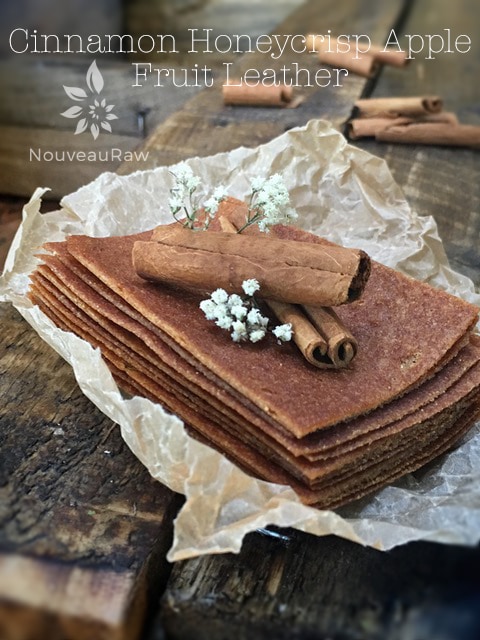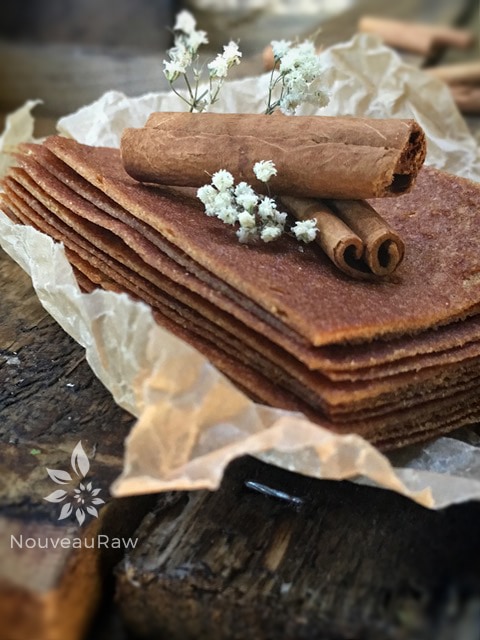Cinnamon Honeycrisp Apple Fruit Leather

 Add to favorites
Add to favorites
 ~ raw, gluten-free, nut-free ~
~ raw, gluten-free, nut-free ~
Honey crisp apples are characterized by an exceptionally crisp and juicy texture. Its flesh is cream-colored and course. The flavor is sub-acid and ranges from mild and well-balanced to strongly aromatic, depending on the degree of maturity. It has consistently ranked as one of the highest quality apples in the University of Minnesota sensory evaluations.
Pick the Right Apple
Look for a large, 3- to 5-inch round fruit with a deep stem crevice. The skin should be taut, medium-thick, with bright red splotches over a yellow field. Expect the surface to feel a bit waxy and slightly uneven.
If, however, the skin is wrinkly or wizened at the stem end, select a different piece of fruit or ask for a discount and take them home for fruit leather recipes! The knock test works best to distinguish between solid and mushy: Snap a fingernail against the apple’s side and expect a crack in reply. If you hear a thud, the flesh will be less crisp than the ideal fruit.
When and where:
Late September through October with fruit from cold storage available into December unless the crop sells out. Most stores will carry the Honey Crisp, but some avoid them because their price continues to be dear. Expect to pay from $2.49 for conventional fruit up to $4 per pound for certified organic.
 Ingredients:
Ingredients:
yields 5 cups puree
- 2 1/2 lbs honey crisp apples
- 2 Tbsp raw honey
- 1 1/2 tsp ground Ceylon cinnamon
Preparation:
- Select RIPE honey crisp apples that have reached a peak in color, texture, and flavor.
- Puree the apples, honey, and cinnamon, in the blender or food processor until smooth.
- Taste and sweeten more if needed. Keep in mind that flavors will intensify as they dehydrate.
- When adding a sweetener do so a little at a time, and reblend, tasting until it is at the desired taste.
- It is best to use a liquid type sweetener. Don’t use granulated sugar because it tends to change the texture.
- Spread the fruit puree on teflex sheets that come with your dehydrator. Pour the puree to create an even depth of 1/8 to 1/4 inch. If you don’t have teflex sheets for the trays, you can line your trays with plastic wrap or parchment paper. Do not use wax paper or aluminum foil.
- Lightly coat the food dehydrator plastic sheets or wrap with a cooking spray, I use coconut oil that comes in a spray.
- When spreading the puree on the liner, allow about an inch of space between the mixture and the outside edge. The fruit leather mixture will spread out as it dries, so it needs a little room to allow for this expansion.
- Be sure to spread the puree evenly on your drying tray. When spreading the puree mixture, try tilting and shaking the tray to help it distribute more evenly. Also, it is a good idea to rotate your trays throughout the drying period. This will help assure that the leathers dry evenly.
- Dehydrate the fruit leather at 145 degrees (F) for 1 hour, reduce temp to 115 degrees (F) and continue drying for about 16 (+/-) hours. The finished consistency should be pliable and easy to roll.
- Check for dark spots on top of the fruit leather. If dark spots can be seen it is a sign that the fruit leather is not completely dry.
- Press down on the fruit leather with a finger. If no indentation is visible or if it is no longer tacky to the touch, the fruit leather is dry and can be removed from the dehydrator.
- Peel the leather from the dehydrator trays or parchment paper. If it peels away easily and holds its shape after peeling, it is dry. If it is still sticking or loses its shape after peeling, it needs further drying.
- Under-dried fruit leather will not keep; it will mold. Over-dried fruit leather will become hard and crack, although it will still be edible and will keep for a long time
- Storage: To store the finished fruit leather…
- Allow the leather to cool before wrapping up to avoid moisture from forming, thus giving it a breeding ground for molds.
- Roll them up and wrap them tightly with plastic wrap. Click (here) to see photos of how I wrap them.
- Place in an air-tight container, and store in a dry, dark place. (Light will cause the fruit leather to discolor.)
- The fruit leather will keep at room temperature for one month, or in a freezer for up to one year.
Culinary Explanations:
- Why do I start the dehydrator at 145 degrees (F)? Click (here) to learn the reason behind this.
- When working with fresh ingredients, it is important to taste test as you build a recipe. Learn why (here).
- Don’t own a dehydrator? Learn how to use your oven (here). I do however truly believe that it is a worthwhile investment. Click (here) to learn what I use.
© AmieSue.com
Tags: Dairy Free, Gluten Free, Nut Free, Refined Sugar Free, Soy Free, sugar free, Vegan



 Add to favorites
Add to favorites
 ~ raw, gluten-free, nut-free ~
~ raw, gluten-free, nut-free ~ Ingredients:
Ingredients: